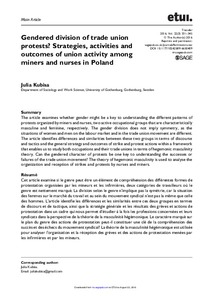Gendered division of trade union protests? Strategies, activities and outcomes of union activity among miners and nurses in Poland

Transfer. European Review of Labour and Research
2016
22
3
August
331-345
gender ; labour dispute ; miner ; nurse ; sexual division of labour ; strike ; trade union
Labour disputes
http://dx.doi.org/10.1177/1024258916650409
English
Bibliogr.
"The article examines whether gender might be a key to understanding the different patterns of protests organized by miners and nurses, two active occupational groups that are characteristically masculine and feminine, respectively. The gender division does not imply symmetry, as the situations of women and men on the labour market and in the trade union movement are different. The article identifies differences and similarities between these two groups in terms of discourse and tactics and the general strategy and outcomes of strike and protest actions within a framework that enables us to study both occupations and their trade unions in terms of hegemonic masculinity theory. Can the gendered character of protests be one key to understanding the successes or failures of the trade union movement? The theory of hegemonic masculinity is used to analyse the organization and reception of strikes and protests by nurses and miners."
Digital;Paper
The ETUI is co-funded by the European Union. Views and opinions expressed are however those of the author(s) only and do not necessarily reflect those of the European Union or the ETUI.